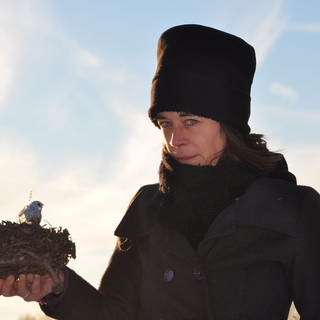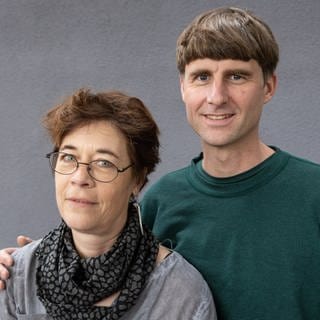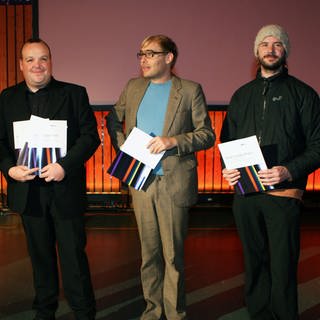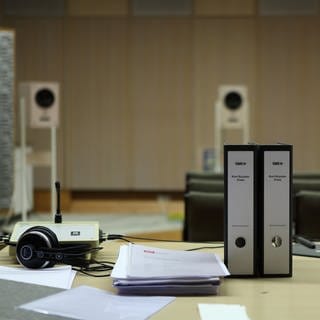The Institut fuer Feinmotorik (Institute for Fine motor skills) is an artist collective that works in various formations on diverse formats. Their experiments with prepared turntables, played with all sorts of crafting materials but consistently without records, have garnered the most attention so far.
The Octogrammoticum
Although we have been dedicated to the concept of prepared turntables since our founding in 1997, we have continually sought to reinvent ourselves. We have released experimental films, published a book, curated exhibitions, organized workshops for children, collaborated with various musicians and sound artists, and built sound sculptures. One sculpture that we have repeatedly experimented with is the OCTOGRAMMOTICUM (Octo = Eight, Grammo = Abbreviation for gramophone, -ticum = Suffix): An experimental setup consisting of 8 turntables and 4 DJ mixers, all packed onto one table, with the turntables prepared with various household materials (adhesive tape, paper clips, paper scraps and labels, rubber bands, wire spirals, etc.). We have learned to regard this table with all its odds and ends as our self-made instrument, creating sounds and noises that often seem austere and sparse, yet possess a unique quality and grace.
Institutionalized friendship as an improvised process
When we stand at this packed table called Octogrammoticum, we improvise. We get to know each other anew and reveal ourselves as old acquaintances. It's a bit like a family dinner where nobody speaks, but communication happens through what is passed around. Yet, nobody asks, "Can you pass me the butter?" Instead, everyone hands over cheese, pepper, or jam as they see fit. Or like an old married couple where precarious balance is the norm. Through this way of working as "institutionalized friends", there usually emerges a continuous thread of acoustic interactions that blend, merge, overflow, build up, and eventually break off. But this time, we wanted something different.
From working with material to studio technology
When the SWR invited us to use the infrastructure of the ZKM for our research in the run-up to Arts Birthday 2011, we decided for the first time to record our tinkering with the Octogrammoticum in multitrack mode. Although it may sometimes sound like it, we have never used effects when working with prepared turntables. While we wanted to remain purist in recording the raw material for the present work to capture the different noises, sounds, and acoustic textures in their uniqueness, we decided after reviewing the material to use some rudimentary techniques such as cutting, separating the individual tracks, and multitrack mixing to enable us to explore a new approach to the material.
We set ourselves the task of a precise acoustic analysis: What interests us about this material in terms of sound, and what new possibilities arise through some simple studio processing techniques regarding the structuring of the material? On the one hand, it was the unmistakable sonic characteristics mentioned earlier that had always driven our work with the Octogrammoticum. We began to explore this quality. Instead of layering sounds on top of each other, we tried to peel them away so that they could unfold in autonomous structures and illuminate themselves in their own light. On the other hand, during this process, we realized that we were not making progress with a "musical" approach and that we had to consider the possibilities of non-musical compositional processes!
From working with the sound sculpture to developing "second-order" sound sculptures
The solution came from the Octogrammoticum itself: We set out to make the concept of the sound sculpture, traditionally applied to our instrument, usable as an acoustic concept and to use it as a model for composition. We wanted to create sculptures out of sound, not musical compositions. Like sculptors, we carved smaller, more delicate figures from rough blocks of long multitrack recordings, removed entire tracks, took individual fragments out of context, and let them speak as singular entities in their own right. They are the true offspring of the Octogrammoticum: sound sculptures that stand on their own feet! With these sculptures, the institute returns to its roots: to the experiment with noises that do not necessarily have to be interpreted as music: to the fascination of acoustic events! These "second-order" sound sculptures (because they are acoustic sculptures whose material was recorded on our sound sculpture) are not physical, yet they exhibit physical qualities. They do not want to merge, but to stand side by side. They have no fixed locations, no predetermined order. It is a collection of sculptures that can be curated anew by changing the sequence of pieces, defining the length of pauses, or perhaps even storing individual sculptures and only "exhibiting" part of the collection.
The result in the form of a temporary exhibition
We have stored 49 individual sound sculptures in a folder. This is the sculpture collection that we have crafted from the raw material, the recordings from the ZKM. This collection and the possibility to exhibit it in various ways repeatedly are the central elements of this work. These 49 acoustic sculptures, along with the one sound sculpture on which the material was recorded (Octogrammoticum), make up the 50 sculptures in the title. Additionally, we curated an "exhibition": all 49 sculptures from the collection were arranged in a sequence, and appropriate distances between each sculpture were defined. This is a way to exhibit these sculptures—a version curated by the artists themselves.
Institut fuer Feinmotorik: Mark Brüderle, Daniel van den Eijkel, Tim Elzer, Marc Matter, and Florian Meyer
The 50 Sculptures of Institut fuer Feinmotorik (2011)
Duration: 46’26 minutes
Realization: Institut fuer Feinmotorik and Tim Elzer
Dramaturgy: Frank Halbig
Production: SWR 2011
Created as part of the 'Arts Birthday' on January 17, 2011
Competition and jury's statement
This year, 80 entries from seven countries were submitted, including 46 productions from ARD and Deutschlandradio. Six productions came from foreign broadcasting corporations, and 25 were from independent authors. The award ceremony took place on October 15 as a public event during the Donaueschinger Musiktage 2011.
The 100 applicants came from Argentina, Australia, Germany, England, France, Greece, Ireland, Italy, Iran, Canada, Croatia, Mexico, Austria, Portugal, Serbia, Switzerland, Slovenia, Spain; Taiwan, Turkey, and the United States of America.
The allocation of awards was decided by an independent jury on Thursday, July 14, 2011, in Baden-Baden. The members were the publicist, literary scholar, and former Minister of State for Culture, Christina Weiss (chair), the writer Marcel Beyer, the literary scholar Michael Grote, the composer Helmut Oehring, and the journalist and musicologist Margarete Zander.
"'Die 50 Skulpturen des Institut fuer Feinmotorik' impressed this year's jury of the Karl Sczuka Prize with their concrete, sensory sound quality as well as their radical consistency. Since 1997, the five-member artist collective Institut fuer Feinmotorik has been exploring the possibilities of its media in experimental performances - working with DJ mixers and prepared turntables, on which everyday materials such as rubber bands, paper clips, and adhesive labels are scanned instead of records. From this bold reduction of radiophonic means emerges an aggregate of sound-formed bodies with a mysterious archaic quality."
The Institut fuer Feinmotorik
We, the Institut fuer Feinmotorik, are an artist collective that works in various formations and formats. Our most notable experiments to date have been with prepared record players, which are played using all sorts of crafting materials, but consistently without actual records.
Mark Brüderle, born in 1974 in Säckingen, resides in the tri-border area around Basel and is a founding member of the Institut fuer Feinmotorik. Additionally, he has performed as DJ Rikrok, in the club music duo Paul Breitner, and in The Beautiful Crew. Apart from music, he is known for his artistic objects, drawings, mirror paintings, and video clips.
Daniel van den Eijkel, born in 1974 in Liesthal, Switzerland, studied sociology, computer science, and cognitive science in Freiburg from 1998 to 2006. Since 2008, he has been living in Berlin and working as a programmer, musician, and DJ. As a founding member of the Institut fuer Feinmotorik, he has released numerous records and other media, performed concerts, and conducted workshops in Europe, North and South America. In addition to the turntable, the use of programming languages (such as SuperCollider) for music production is one of his central areas of interest. Currently, he is working on project-based collaborations with Christoph Coburger and Konrad Sprenger, among others.
Tim Elzer, born in 1974 in Speyer, studied musicology at the University of Cologne from 1996 to 1998 and then continued his studies at the Academy of Media Arts Cologne from 1998 to 2002. From 2004 to 2007, he held a studio scholarship from the Cologne Art Association. He lives and works in Speyer as a freelance sound designer for film projects, musician/composer, and disc jockey. In 1998, he released the solo LP "Don't Dolby 05" on Gefriem Tonträger, Cologne. In 1999, he performed his first joint concerts with the artist group nstitut fuer Feinmotorik (which developed into a regular collaboration in the following years). In 2000, he produced a radio program for Radio Lora, Zurich, together with Andreas Hirsch. In 2001/2002, he composed film music and sound design for "Unternehmen Paradies" by Volker Sattel. In 2003, he contributed various texts to the "Feinmotorik Kompendium." In 2004, he (together with Marc Matter) worked as a musician/program designer at the Ruhrfestspiele Recklinghausen and composed a soundtrack for the video installation "Living Tomorrow" by Linda Wallace in Amsterdam. In 2005, he realized (together with Marc Matter) the event series "REPRISE - Fine Motor Excursions in Sound and Image" in Cologne. In 2006, he took over the sound design for "Laufhaus" by Steffi Gaus, and in 2008 for "Steinfliegen" by Anne Walther. In 2009, he composed film music and sound design for "Legenden" by Angélique Dubois. In 2010/2011, he was responsible for the sound design for "Unter Kontrolle" by Volker Sattel.
Marc Matter, born in 1974 in Basel, is a founding member of the artist group Institut fuer Feinmotorik, with which he has released numerous records, an experimental film, a book, and other works since 1997. He has traveled to Europe, South America, and the USA for performances and workshops. From 1999 to 2004, he studied at the Academy of Media Arts Cologne, where he studied under Valie Export and Siegfried Zielinski, among others. He conducted intensive research on artist publications (artist books, artist records, etc.), sound art, poésie sonore, experimental film, and acoustic art. He lives as a media artist, musician, experimental DJ, and author in Düsseldorf and Brussels. He is involved with the Salon des Amateurs, an independent venue and music club under the Kunsthalle Düsseldorf. Since 2010, he has been a lecturer for Text & Music at the Institute for Music and Media of the Robert Schumann University of Music Düsseldorf. He participates in various music projects, including the experimental club music groups Harmonious Thelonious and The Durian Brothers, as well as the avant-garde pop musician Niobe from Cologne.
Together with Marcus Maeder and Bernd Schurer (domizil), he interpreted the Dadaist novel "Tenderenda der Phantast" by Hugo Ball as an experimental radio play for Swiss Radio DRS2. In 2005, the anthology "Feinmotorik Kompendium" was published, an artist's book in the form of a lexicon. At the end of 2009, the piece "Radio-Imitat" produced for Radio Arthur was released on CD. With Institut fuer Feinmotorik, he recently released the LP "Abgegriffen" on the US label Marriage Records.
Florian Meyer, born in 1976 in Berlin, studied at the State University of Design in Karlsruhe and has been a founding member of the artist collective Institut fuer Feinmotorik since 1997, releasing several records, a book, an experimental film, and other works. He has performed concerts and conducted workshops in Europe, South and North America, as well as in Japan. In the media of film, photography, and conceptual art, he has participated in solo and group exhibitions, including at ZKM Karlsruhe, Westwerk Hamburg, and Ohashi Satelite in Fukuoka. Together with friends, he runs the artistic T-shirt manufacturing company 'copy and paste', the experimental musical university label 'ichiigai', and the record label 'Diskant'. There, he has realized some of his solo and group projects, such as 'MSP' - illuminative and sonic experiments with art spaces, 'fff' - a solo project exploring the DJ mixer as an instrument, or the 'Durian Brothers', dedicated to an experimental approach to producing club music. Recently, the second EP of the 'Durian Brothers' - "Cuts EP" - was released on Diskant. The Portland, Oregon-based record label also released the long-play record "Abgegriffen" by Institut fuer Feinmotorik.
Florian Meyer currently lives as a freelance artist, musician, composer, and DJ in Fukuoka, Japan, where he is a recipient of the Karl Steinbuch Scholarship at Kyushu University, developing a parallel circular sequencer. As 'Don't DJ', he is a guest at a series for contemporary tropical dance music at 'Cream'.





